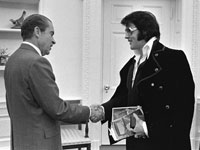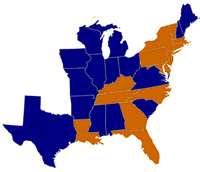1. Accused of adultery, gambling, bigamy, drunkenness, theft, lying, and murder:
Andrew Jackson. During the 1828 election, a pamphlet was circulated: Reminiscences; Or, an Extract from the Catalogue of General Jackson's Youthful Indiscretions, between the Ages of Twenty-three and Sixty, listing his fights, duels, brawls, and shooting and cutting affairs.
2. Accused of using his father’s money to buy votes during the election. He responded publicly in a speech with these words: “I just received the following wire from my generous Daddy: ‘Don’t buy a single vote more than necessary. I’ll be d*** if I’m going to pay for a landslide."
John F. Kennedy. In Wisconsin in 1960, someone once joked to Kennedy, "I hear that your dad only offered two dollars a vote. With all your dough, can't you do better than that?" "You know that statement is false," replied Kennedy. "It's sad that the only thing you have to offer is your vote, and you're willing to sell that."
3. Accused of being a despot, liar, thief, braggart, buffoon, usurper, monster, ignoramus, scoundrel, perjurer, robber, swindler, tyrant, fiend, and butcher:
Abraham Lincoln. Of the election of 1864, Lincoln said: "It is a little singular that I, who am not a vindictive man, should have always been before the people for election in canvasses marked for their bitterness."
4. Accused of cheating creditors, robbing an old widow of her pension, behaving like a coward during war, being an atheist. It was said that if he became president, surely he would confiscate all Bibles in the land and have them burned, tear down all churches, and dissolve the institution of marriage:
Thomas Jefferson. The Federalists struggled to keep their party alive and even set forth a rumor that Democratic-Republican Jefferson had died and that it would be a waste of time to vote for him.
5. Accused of being a fool, hypocrite, criminal, tyrant, bald, blind, crippled, toothless man who aimed to become King of America and align with Britain:
John Adams. Opponents claimed that he wanted one of his sons to marry one of King George III's daughter, forming an Anglo-American dynasty.
 False. Advertising executive Rosser Reeves had previously created the "melts in your mouth, not in your hands" campaign for M&Ms. The campaign he planned for Eisenhower—20-second spots designed to run before or after popular television shows like I Love Lucy—featured "normal Joe" citizens asking Eisenhower questions about taxes, foreign policy, and other issues. Eisenhower answered in a brief, blunt, homey fashion, with the format giving the campaign its name: "Eisenhower Answers America." Prior to this campaign, presidential candidates had brushed off the potential of television advertising; following it, ads became an accepted and increasingly central aspect of campaigning.
False. Advertising executive Rosser Reeves had previously created the "melts in your mouth, not in your hands" campaign for M&Ms. The campaign he planned for Eisenhower—20-second spots designed to run before or after popular television shows like I Love Lucy—featured "normal Joe" citizens asking Eisenhower questions about taxes, foreign policy, and other issues. Eisenhower answered in a brief, blunt, homey fashion, with the format giving the campaign its name: "Eisenhower Answers America." Prior to this campaign, presidential candidates had brushed off the potential of television advertising; following it, ads became an accepted and increasingly central aspect of campaigning. True. JFK's 1960 campaign for the presidency, run by two different advertising agencies, included a multitude of television advertisements and a dizzying array of techniques and appeals. Several of the ads spoke out to specific demographics—including a spot in which Jackie Kennedy, speaking in uneven Spanish, assured voters that, in the face of the danger of communism, "Mi esposo siempre vigilará los intereses de todos los sectores de nuestra sociedad que necesitan la protección de un gobierno humanitario" (or, "My husband will always watch over the interests of all sectors of our society who are in need of the protection of a humanitarian government"). Other ads spoke to the African American community, assuring the public that Kennedy's Catholicism would not compromise his presidential duties.
True. JFK's 1960 campaign for the presidency, run by two different advertising agencies, included a multitude of television advertisements and a dizzying array of techniques and appeals. Several of the ads spoke out to specific demographics—including a spot in which Jackie Kennedy, speaking in uneven Spanish, assured voters that, in the face of the danger of communism, "Mi esposo siempre vigilará los intereses de todos los sectores de nuestra sociedad que necesitan la protección de un gobierno humanitario" (or, "My husband will always watch over the interests of all sectors of our society who are in need of the protection of a humanitarian government"). Other ads spoke to the African American community, assuring the public that Kennedy's Catholicism would not compromise his presidential duties.  False. Nixon's 1972 campaign for reelection cast him as a man of "compassion, courage, and conscience," concerned about many issues, including environmentalism and international diplomacy, as well as withdrawing from Vietnam. President Nixon, one ad declared, was willing to press for change, because "without change there can be no progress." The ads crafted the argument that Nixon, far from being cold and unapproachable, was personable and personally interested in a global push for peace and wellbeing nationally and internationally. Nixon won the campaign against South Dakota Senator George McGovern by a landslide.
False. Nixon's 1972 campaign for reelection cast him as a man of "compassion, courage, and conscience," concerned about many issues, including environmentalism and international diplomacy, as well as withdrawing from Vietnam. President Nixon, one ad declared, was willing to press for change, because "without change there can be no progress." The ads crafted the argument that Nixon, far from being cold and unapproachable, was personable and personally interested in a global push for peace and wellbeing nationally and internationally. Nixon won the campaign against South Dakota Senator George McGovern by a landslide. False. Though most of Ronald Reagan's ads stressed the economic wellbeing of the U.S., using montages of small-town Americans engaged in rituals such as weddings and buying new homes, one stuck out. The unusual ad showed a bear lurking in the woods; the accompanying narration suggested that the bear might or might not exist and might or might not be dangerous, but "since no one can really be sure who's right, isn't it smart to be as strong as the bear? If there is a bear?" Though the ad never explicitly states what the bear stands for, the advertisement's creators intended it to symbolize the Soviet Union. The ad's watchers, however, took it as commenting on any number of issues, including gun control and the need for change in environmental laws. Despite its ambiguity, the ad gained attention and later served as inspiration for an ad in George W. Bush's 2004 reelection campaign.
False. Though most of Ronald Reagan's ads stressed the economic wellbeing of the U.S., using montages of small-town Americans engaged in rituals such as weddings and buying new homes, one stuck out. The unusual ad showed a bear lurking in the woods; the accompanying narration suggested that the bear might or might not exist and might or might not be dangerous, but "since no one can really be sure who's right, isn't it smart to be as strong as the bear? If there is a bear?" Though the ad never explicitly states what the bear stands for, the advertisement's creators intended it to symbolize the Soviet Union. The ad's watchers, however, took it as commenting on any number of issues, including gun control and the need for change in environmental laws. Despite its ambiguity, the ad gained attention and later served as inspiration for an ad in George W. Bush's 2004 reelection campaign. To watch all of the ads mentioned in this quiz, check out the Museum of the Moving Image's website
To watch all of the ads mentioned in this quiz, check out the Museum of the Moving Image's website 

 1848
1848 1856
1856 1852
1852 1860
1860 1844
1844 1840
1840 1864
1864